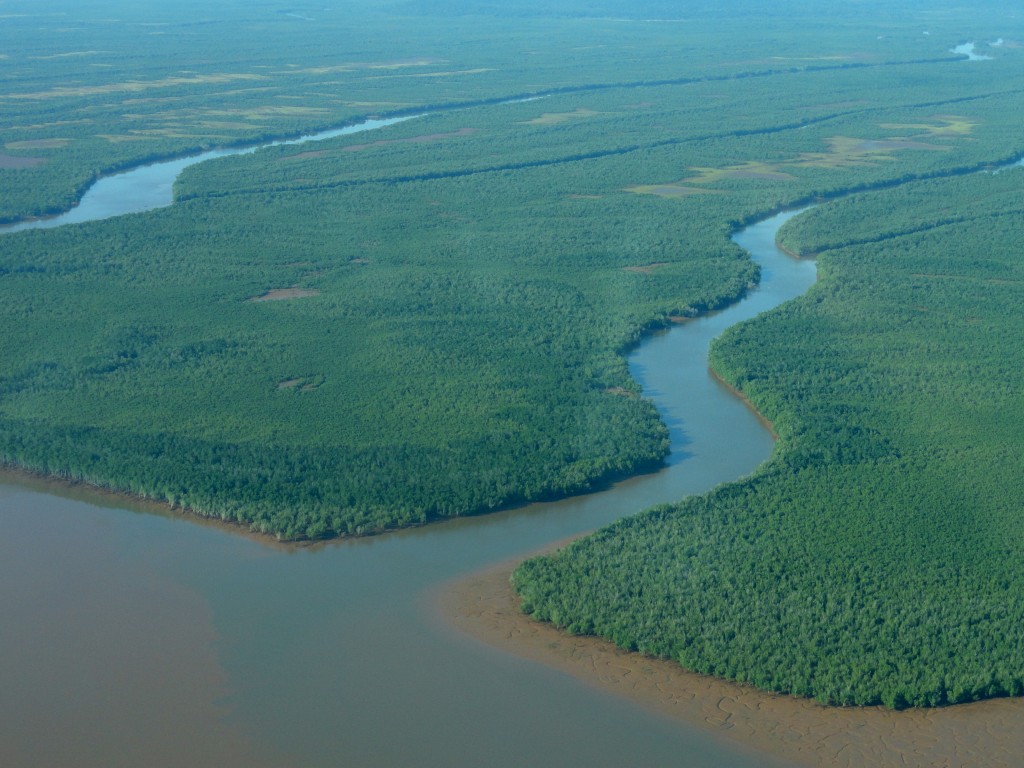by Trevor Jones, Remote Sensing Scientist, Madagascar
Greetings from Mahajamba bay, home of Madagascar’s largest mangrove ecosystem. The Blue Ventures Blue Forests team has been stationed here since early August conducting a month long field campaign.
Hosted by and working closely with the aquaculture firm Aqualma, our biomass scientists have been establishing field plots to inventory carbon stocks, guided by a preliminary survey in which ecological variability was determined in June. To do this, the Blue Forests team must stare down the usual array of challenges, notably without complaint, including crawling through waist deep mud for hundreds of metres, traversing extensive mudflats, or “tannes”, which can reach 10 km in length, battling the seasonal “varatraza” winds while crossing the massive bay, and contending with exceptionally bountiful and ever-hungry populations of mosquitoes, which are in fact so bountiful that the name of one nearby village, ‘Bealoy’, literally translates to ‘too many mosquitoes’
The Blue Forests team aims to sample a comprehensive representation of variability in the above and below ground carbon stocks of mangrove trees and soil, and areas that were once/could transition into mangrove habitats. We also are striving to thoroughly document the dynamics between mangroves and their surroundings, both human and natural. Our area of investigation is simply immense; travel times to and between sampling sites are measured in not minutes, but hours, and measuring carbon is an inherently laborious task. However, impressively, nearly 60 plots have been established in just 18 field days.
Out of the mud, the socio-economic crew has been hard at work visiting communities adjacent to the bay. They have successfully conducted numerous workshops and focus groups, yielding detailed information on the historical and contemporary relationships between these communities and mangroves. The scope of ground to be covered was daunting, but we now have a wealth of relevant socio-economic information, which acts as a timeline of human interaction and resource-use, and helps determine the ramifications of changes to these relationships.
Through the collective observations of the Blue Forests team, it is clear that widespread human-caused degradation and deforestation is not nearly as prevalent as elsewhere in the country (such as in Ambaro and Ambanja Bays); however, analysis of satellite imagery, contextualized by field observations and socio-economic research, reveals an acceleration in mangrove degradation and loss within the past 10-15 years. The primary human-related contribution is increased large-scale timber extraction for commercial sale and exportation. To a comparatively lesser degree, small-scale resource extraction for traditional uses, such as dwelling construction, is also responsible for widespread yet low-impact degradation. The impact of natural processes and phenomena, particularly die-off due to cyclones and increased erosion and sediment deposition, is also evident.
The estimated 26,000 hectares of mangroves in Mahajamba Bay not only store a tremendous amount of “blue carbon”, but also provide crucial resources to communities and provide homes to a diverse range of unique, and in certain instances threatened, flora and fauna. Surrounding terrestrial and other marine ecosystems, which are inextricably linked with the mangroves, are equally important to the long-term future of the area and its residents. Owing to the relatively sparse human population in and around the bay, Mahajamba’s mangroves currently remain largely intact, but as population continues to grow, pressures on mangroves and all ecosystem types in and around the bay are likely to increase. Notably, declines in fish and shrimp catches have already been witnessed by local fishing communities, and the degradation of terrestrial forests is apparent.
With a mandate to represent the highest standard in responsible aquaculture practices, and place acute attention on environmental and social impacts in and around their facilities, Aqualma recognizes the importance of working hand-in-hand with community members to safeguard Mahajamba Bay’s collective ecological integrity. Given their potential footprint and influence, Blue Ventures’ partnership with Aqualma is critical for effectively developing and implementing viable long-term strategies. In addition to Aqualma’s support, encouragingly, community leaders seem aware of the issues at hand and acknowledge the risks associated with over-exploitation. However, given the lack of close proximity to heavily overexploited areas, it is likely that to many residents, the vast mangrove forests seem misleadingly inexhaustible.
Together with Aqualma, we must continue to work towards empowering vulnerable coastal communities with the knowledge to conserve, restore, and plan the long-term use of mangrove and adjacent resources, which in turn will help secure critical ecological services and protect flora and fauna.

Coquerel’s Sifaka (Propithecus coquereli). On the IUCN’s Red List of Threatened Species and found in the terrestrial forest surrounding the mangroves.
In the coming months, after having completed four month-long field campaigns in 2012, the Blue Forests team will be piecing together a huge array of data sets. The results of our analyses are expected to yield an unprecedented collection of information regarding the carbon stocks, dynamics, and underlying drivers of change for Madagascar’s two largest mangrove ecosystems. This will ultimately allow us to assess the feasibility of and implement (as deemed suitable) payments for ecosystem services (PES) and carbon financing mechanisms, ensuring communities are placed firmly as the primary stakeholders. Improving and sustaining the livelihoods and climate change preparedness of these increasingly vulnerable coastal communities remains the core goal of our work.






